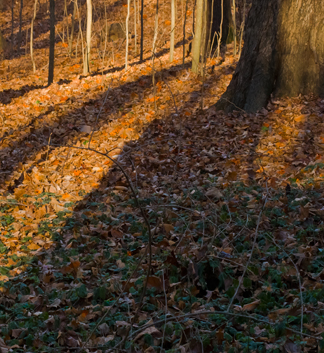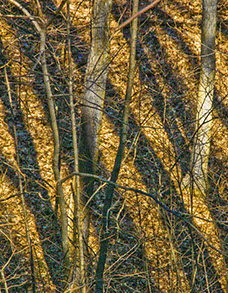
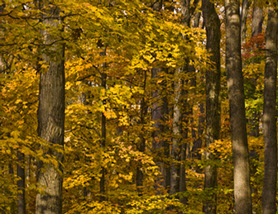
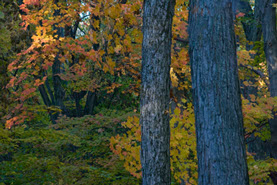
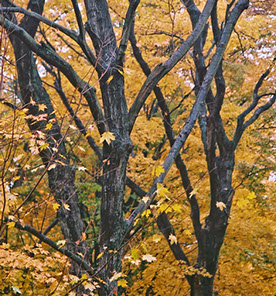
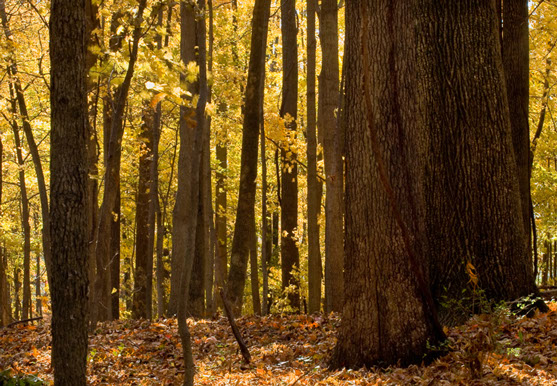
The invasion of our forest by alien colors starts covertly with scattered hints of cowardly yellowishness high up in tops of the blackish green trees, easily missed. Still timid, the assault descends from the canopies like our coons descend hind-first from those trees, becoming ever bolder, like the coons banging at our back door.
It’s blatantly gold now, the color of courage.
Golds and more golds. Gold rules over a kingdom of fresh oranges, and reds, azo reds, Chinese reds, Venetian reds, and mauves, and scarlets. But to the golds belong the hegemony, golds of all hues from the subliminally greenish golds not quickly discovered among Pantone swatches, to the fiery golds saturated beyond the gamuts of all electronic color spaces, celebrated by a pageant of fluorescent regal banners, pennants, tapestries. The triumph is total. But brief, of course.
Like a squad of commandos storming down a mesh from helicopters, the gold has swooped down to occupy the forest from sky to ground. Now we are living inside a wall of homogeneous gold, Babylonian walls of pure gold, opulent, legendary, impenetrable, scary if you are claustrophobic. A vaulted gothic cathedral with thick opaque walls of solid gold and gold-stained glass windows with touches of iridescent scarlets. A tsunami of gold, an immersion experience. You close your eyes and the gold is still laser beaming into your retina, and memory.
The gold is explosive, igniting and consuming the whole woods, leaving everwhere else only bleak wreckage and cold and silence.
The curtain begins to fall and the finale begins as quietly as the show began, in gentle flutterings of gold leaves, clouds of golden butterflies fluttering to the ground. There is a nice brisk wind scudding cottony clouds at a good clip across the cobalt sky way up there, and the whole golden scene is turned from a still life into kinetic sculpture, i-Max movie, fluttering gold on branches, swirls and gavottes in the air, little flurries on the ground, the gold comes alive. Neat architectural fenestrations, peek holes, are being punched through the once solid walls of gold, letting sky show through, widening into gaping rents, ripping the fine gold-enmeshed tapestry to tatters. stripping off the canopies, exposing the trunks and the ground, but not yet to shame.
On the ground a film of see-through gold thickens to become a gold blanket, forming drifts of gold taking over the earth, notably our long driveway, as thick as the snow yet to come, a glacier of gold leaves covering this portion of Ohio, as did the Ice Age -- patterned into a grate by stark, elongated, computer-exact parallel shadows of the black suddenly statuesque trees.
And now it is over.
Recurring every year exactly on schedule, like clockwork, always starting the second week of October, peaking around October 29, lasting about a month, it’s over by early November – this is our annual ColorFest. All year I look forward to it with more excitement than to the Super Bowl Halftime Extravaganzapalooza featuring wardrobe malfunctions. There's something about the Fall that makes all people need to celebrate one way or another. Of jubilees that exploit if not celebrate color there's Holween with wicked oranges and blacks tat RiteAid and Lowes, in August. And every little town around here has an OctoberFest with parades, beer, polka and rock bands, piles of pumpkins, art shows, and syrup concessions. But the unimaginable color out there in the forest is most meaningfully celebrated not at any bacchanal but by worship, but not at church but out there in it, with gasped prayers of awe. Thank you, God, thank you!
Having been born and raised in the drab Southern California of the 1930s and ‘40s when San Fernando Valley was only tumble weeds, unremittingly colorless, such seasonal brazen, conquering color puts me into rapture. The first time I beheld all this, in 1978 I believe, I was incredulous, dumbfounded. Though my ear had heard of it, my eye had never seen the fullness and power of such color. It must be a fluke. But it wasn’t. It was routine, it has never failed. Every year I exclaim, “what colors, this must be the best yet!” But next year would be as intemperately glowing, however dry the summer and temperate the fall had been. When it was time, it came.
A trained medical scientist, I have for decades kept records, notes, yearly journals and daily diaries, charts, graphs, documenting and detailing the beginning points, vectors and velocities of color surges, and the proportions of gold to green, of leaf mass to opening sky and to exposed trunks, of branch-bearing gold mass to thickness of ground drifts.
But I am even more helplessly impelled to write essays with elongated compound sentences that don’t pause for breath, and there goes any pretense of adhering to Strunk and White’s stark style (Elements of Style), and all hope of reining in the stampede of metaphors and similes and hyperboles. Like the gold takes over our forest, metaphors, not necessarily golden, take me over. However, I respect admonitions against adjectives. “Vibrant” and “dazzling” and “blinding,” even “aureate” must be expurgated. “Fulgent” must go. But the expurgation is hardly noticeable. Plenty of adjectives left, too many.
However bedizened with metaphors and adjectives, essays are chaste and constrained compared to seasonal poetic license. When Jack Frost transforms green to gold every man is transformed into a Robert Frost. It gets truly “treacly.” Speaking of which (“treacly”), all I knew about sugar maples when we moved here from California was that when gouged syrup seeps out. Never especially cared for syrup.
Between readings of poetry, the syrupier the better, those dire strictures against adjectives and tropes were delivered, as they should be, by high school English teachers. That was long, long ago. Yet to come -- has in fact come as seen in all those e-mail forwards -- the greatest curse that colors ever faced: Photoshop, by which golden trees are morphed into zombies dripping blood, to me even more sinful than verbal gluttony.
I renounce Photoshop’s parodies. Parables likewise, and the homilies, and extracted morals that want to accompany the gold as surely as the syrup seeps. The mystic sees, in the brief crown of gold whiplashed by winter wreckage, parabolic angst, and in the fall of leaves, the Fall of Man, and In the brevity of glory, the aging and mortality of man. An octogenarian whose golden curls have been supplanted by sorry shreds of silver, I say, “sufficient unto the day is the evil thereof.” Meanwhile, sufficient unto this day is the glory.
Ohio is not known for color like New England or Canada are, where roams the Acer rubum. Here in Ohio when the summer winds down, all the hillsides, previously lush green, look like overcooked church casseroles. The forsythias in their pots hanging from the eaves of porches that a month ago were perky and spreading like the chestnut tree in Longfellow’s poem are now dried tobacco. Leaves are disappearing like bored students ducking out of class. Among the scattered clusters and runs of trees residual in the farmlands and countryside, or imported into the suburbs, the walnuts and any remaining elms don’t work like they do in New England but go drab with only a T.S. Eliotean whimper, with only odd scattered bursts of color from sumac, detonating like roadside bombs in Iraq.
But That's not what we see. Luckily we live in a unique domain. We live in a dense forest of almost solid sugar maples – Acer saccharum – with enough sassafras for scarlet accents, one of the older such forests left in Ohio with trees up to three feet in diameter and 200 feet tall -- a secret forest known only to locals, one of whom happened to be the real estate agent who sold us our five acres of color. In Sugarcreek Township. On Sugarhill Lane.
We don't live there any more. Aged, depleted of luck and so much else, we moved to a Southern California retirement community.
And today is November 4, and I know the golden month back on Sugarhill Lane, is over. But I am thinking: The gold of the leaves of our maple trees, fluorescent, gleaming, fluttering, breath-thin but living gold, is more precious, if for but one lost moment that endures for eternity, than the most costly genuine gold of any Hollywood celebrity's gold lamé dress or nose ring.
I took all these photos, within a couple of hundred feet of our house. Canon Rebel, D50
